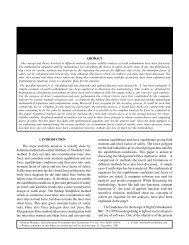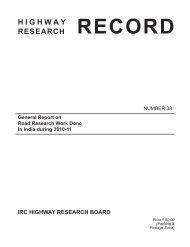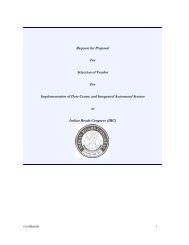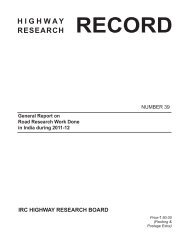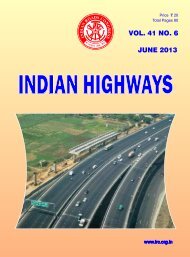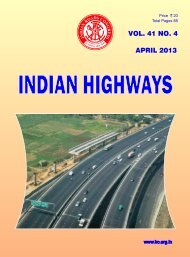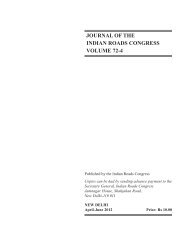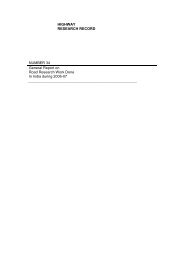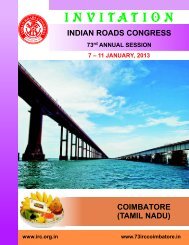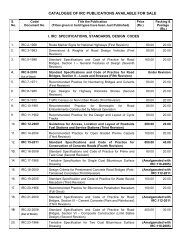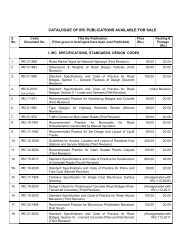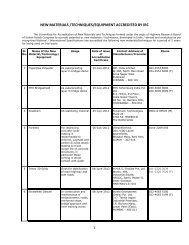A Review of Highway Agencies in the South Asia Region
A Review of Highway Agencies in the South Asia Region
A Review of Highway Agencies in the South Asia Region
You also want an ePaper? Increase the reach of your titles
YUMPU automatically turns print PDFs into web optimized ePapers that Google loves.
A <strong>Review</strong> <strong>of</strong> <strong>Highway</strong> <strong>Agencies</strong> <strong>in</strong> <strong>the</strong> <strong>South</strong> <strong>Asia</strong> <strong>Region</strong><br />
research projects, <strong>in</strong>clud<strong>in</strong>g:<br />
Accelerated pavement test<strong>in</strong>g (rigid and flexible pavements);<br />
Updation and revision <strong>of</strong> technical methods for highways and technical<br />
recommendations for highway documentation;<br />
Cost-effective ways to upgrade gravel roads;<br />
Large tri-axle test<strong>in</strong>g; and<br />
Pedestrian safety management.<br />
C1.5 F<strong>in</strong>anc<strong>in</strong>g Road Infrastructure<br />
C1.6 Performance Indicators<br />
SANRAL uses two mechanisms for f<strong>in</strong>anc<strong>in</strong>g its assets. The SANRAL Act (1998) stipulates a<br />
dist<strong>in</strong>ct separation <strong>in</strong> <strong>the</strong> fund<strong>in</strong>g <strong>of</strong> its operations:<br />
Non-toll roads are funded by government allocations, and are not allowed to borrow or<br />
be cross-subsidized from toll road <strong>in</strong>come, and vice versa; and<br />
Toll operations can be divided <strong>in</strong>to two types – those funded by SANRAL itself and<br />
operated on its behalf, and roads concessioned to private parties under PPPs.<br />
Toll Operations<br />
F<strong>in</strong>anc<strong>in</strong>g<br />
Revenues from toll and funds raised on <strong>the</strong> capital market are used to f<strong>in</strong>ance toll roads.<br />
SANRAL is backed by a government guarantee <strong>of</strong> US$820 million.<br />
All borrow<strong>in</strong>gs are repaid by <strong>the</strong> toll fees collected from users <strong>in</strong> accordance with <strong>the</strong> “user<br />
pays” pr<strong>in</strong>ciple that SANRAL has employed s<strong>in</strong>ce 1998. Consequently, <strong>the</strong> cost <strong>of</strong> borrow<strong>in</strong>g<br />
has an impact on road-user costs. The <strong>in</strong>itial toll tariff is generally determ<strong>in</strong>ed <strong>in</strong> <strong>the</strong> range <strong>of</strong><br />
80 percent <strong>of</strong> <strong>the</strong> user benefit provided by <strong>the</strong> toll route. These tariffs are adjusted annually<br />
for <strong>the</strong> consumer price <strong>in</strong>dex, approved by <strong>the</strong> M<strong>in</strong>ister <strong>of</strong> Transport and gazetted.<br />
The volatility <strong>of</strong> construction, ma<strong>in</strong>tenance and operations costs has led SANRAL to<br />
exam<strong>in</strong>e o<strong>the</strong>r toll-tariff structures. SANRAL is consider<strong>in</strong>g shift<strong>in</strong>g from a user-benefit<br />
model to a cost-plus model. The user-benefit model is based on sav<strong>in</strong>gs <strong>in</strong> distance, vehicle<br />
operat<strong>in</strong>g costs and time, for which a percentage <strong>in</strong> <strong>the</strong> range <strong>of</strong> 80 percent is used to<br />
determ<strong>in</strong>e tariffs with <strong>the</strong> result that benefits to <strong>the</strong> road user exceeds <strong>the</strong> value <strong>of</strong> <strong>the</strong> tariff.<br />
The cost-plus model is based on <strong>the</strong> actual cost <strong>of</strong> provid<strong>in</strong>g <strong>the</strong> toll road, a marg<strong>in</strong> <strong>of</strong> which<br />
is used to determ<strong>in</strong>e <strong>the</strong> tariff.<br />
Two pr<strong>in</strong>ciples have been <strong>in</strong>troduced by SANRAL <strong>in</strong>to its toll road bus<strong>in</strong>ess portfolio:<br />
Comprehensive Toll Road Operations and Ma<strong>in</strong>tenance (CTROM) contracts and <strong>the</strong><br />
Concession<strong>in</strong>g <strong>of</strong> Toll Roads.<br />
Roads under CTROM contracts are operated and ma<strong>in</strong>ta<strong>in</strong>ed by <strong>the</strong> private sector <strong>in</strong><br />
accordance with set performance criteria. The latter broadly provide that <strong>the</strong> operators take<br />
responsibility for <strong>the</strong> complete range <strong>of</strong> operations and ma<strong>in</strong>tenance <strong>of</strong> <strong>the</strong> toll route <strong>in</strong><br />
return for a publicly tendered fee. CTROM contracts are now firmly established, and plaza<br />
and rout<strong>in</strong>e road ma<strong>in</strong>tenance operations are runn<strong>in</strong>g well on <strong>the</strong> toll road network.<br />
Also PPPs have been <strong>in</strong>troduced where <strong>the</strong> road is concessioned for a period <strong>of</strong> time (30<br />
years) to a concessionaire that is responsible for <strong>the</strong> fund<strong>in</strong>g, ma<strong>in</strong>tenance and operation,<br />
<strong>in</strong>clud<strong>in</strong>g future upgrades <strong>of</strong> <strong>the</strong> road. Each road is a self-conta<strong>in</strong>ed f<strong>in</strong>ancial entity, run<br />
<strong>in</strong> terms <strong>of</strong> conventional company law (<strong>in</strong>clud<strong>in</strong>g pay<strong>in</strong>g tax as any company). An overall<br />
concession price is negotiated that could <strong>in</strong>clude some form <strong>of</strong> shadow toll<strong>in</strong>g agreement.<br />
SANRAL monitors its activities and performance through a set <strong>of</strong> performance <strong>in</strong>dicators.<br />
122



